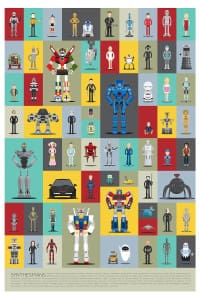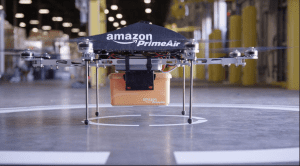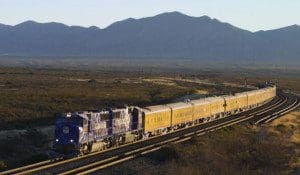 C3PO. R2D2. Johnny 5. Optimus Prime. Voltron. HAL 9000. Wall-E. Terminator. Rosie the maid. Bender. You might notice a theme here. This a short list of some of my favorite robots. These robots can do lots of things: help save the galaxy from evil, understand mortality, travel through time to kill (or protect) Sarah (or John) Connor, control space crafts, clean houses, or be the life of the party. What’s one thing you won’t find in this list? A robot that pick items from shelves and packages it safely in a box. So Amazon is working on that for us. At ICRA 2015 in May, Amazon will host a contest where contestants will build their own robots with the sole purpose of deftly picking and packing items from shelves. According to Amazon, the challenge combines object recognition, pose recognition, grasp planning, compliant manipulation, motion planning, task planning, task execution, and error detection and recovery. The robots will be scored by how many items are picked in a fixed amount of time, with $26,000 in prizes being awarded. The introduction of more automation into the warehouse can certainly lead to cost savings from a labor standpoint, but we are still a ways away from fully replacing human workers. It may not be as exciting as time traveling robots protecting mankind, but it is certainly a step ahead of Rock ‘Em Sock ‘Em Robots.
C3PO. R2D2. Johnny 5. Optimus Prime. Voltron. HAL 9000. Wall-E. Terminator. Rosie the maid. Bender. You might notice a theme here. This a short list of some of my favorite robots. These robots can do lots of things: help save the galaxy from evil, understand mortality, travel through time to kill (or protect) Sarah (or John) Connor, control space crafts, clean houses, or be the life of the party. What’s one thing you won’t find in this list? A robot that pick items from shelves and packages it safely in a box. So Amazon is working on that for us. At ICRA 2015 in May, Amazon will host a contest where contestants will build their own robots with the sole purpose of deftly picking and packing items from shelves. According to Amazon, the challenge combines object recognition, pose recognition, grasp planning, compliant manipulation, motion planning, task planning, task execution, and error detection and recovery. The robots will be scored by how many items are picked in a fixed amount of time, with $26,000 in prizes being awarded. The introduction of more automation into the warehouse can certainly lead to cost savings from a labor standpoint, but we are still a ways away from fully replacing human workers. It may not be as exciting as time traveling robots protecting mankind, but it is certainly a step ahead of Rock ‘Em Sock ‘Em Robots.
And now, on to the news.
- Instacart to charge more during peak delivery times
- Zulily upends its supply chain model
- Amazon urges faster FAA approval of drones
- Freight rail is king in US
- 2015 MHI Annual Industry Report – Supply chain innovation
- Diesel starts new downward trend, falls 5.3 cents in latest week
 Instacart, the one-hour grocery delivery company based in San Francisco, is introducing a new pricing model during peak delivery times. Named “Busy Pricing”, the new structure would charge a minimum fee of $1, although the fee could be higher. The customer will have full transparency into the pricing, and can choose to pay the additional fee or choose another delivery time. This move is being implemented to guarantee that specific delivery times will be available. Due to its popularity, the site can sometimes be overwhelmed with requests for certain times, such as Sunday nights. This gives Instacart a little bit of wiggle room. It is also a proven business model, as Uber has implemented surge pricing during busy times (although not to everyone’s liking).
Instacart, the one-hour grocery delivery company based in San Francisco, is introducing a new pricing model during peak delivery times. Named “Busy Pricing”, the new structure would charge a minimum fee of $1, although the fee could be higher. The customer will have full transparency into the pricing, and can choose to pay the additional fee or choose another delivery time. This move is being implemented to guarantee that specific delivery times will be available. Due to its popularity, the site can sometimes be overwhelmed with requests for certain times, such as Sunday nights. This gives Instacart a little bit of wiggle room. It is also a proven business model, as Uber has implemented surge pricing during busy times (although not to everyone’s liking).
Part of Zulily’s business model was to hold zero inventory. This kept inventory costs minimal, and the savings were passed on to the consumer. The company would purchase merchandise only after their customers ordered it. The problem with this model was the time it took to ship merchandise to customers. According to the Wall Street Journal, the average time it took for an order to leave a Zulily warehouse in Q4 of 2014 was 13.7 days. While their flash sales may have saved customers money, it certainly didn’t win anyone over when they would have to wait two weeks or more to get their order, especially considering their competition could fulfill next day (and in some cases, same day). So Zulily has abandoned this model and will stock inventory in warehouses that will be owned by vendors until it is sold. It may drive prices up a bit for the end consumer, but in today’s instant gratification world, sometimes a price increase just makes sense.
 The Amazon drone saga continues. Weeks after the FAA released its proposed drone guidelines, which essentially killed Amazon’s drone plans for the US, Amazon is urging the FAA to speed up the approval process. On Tuesday, an Amazon official told a senate panel “the Federal Aviation Administration is so slow to approve drone permits that the aircraft become obsolete while waiting.” Amazon was granted approval for a test drone, but the months-long wait for regulations made that drone obsolete. As a result, Amazon applied for a new permit for an updated aircraft. At the heart of the matter is Amazon’s view of the drone versus that of the FAA. Any changes to the proposed regulations will have a significant impact on drone deliveries states-side.
The Amazon drone saga continues. Weeks after the FAA released its proposed drone guidelines, which essentially killed Amazon’s drone plans for the US, Amazon is urging the FAA to speed up the approval process. On Tuesday, an Amazon official told a senate panel “the Federal Aviation Administration is so slow to approve drone permits that the aircraft become obsolete while waiting.” Amazon was granted approval for a test drone, but the months-long wait for regulations made that drone obsolete. As a result, Amazon applied for a new permit for an updated aircraft. At the heart of the matter is Amazon’s view of the drone versus that of the FAA. Any changes to the proposed regulations will have a significant impact on drone deliveries states-side.
 When it comes to freight shipped between US cities, the rail is still king. In fact, railways carry more than 40% of the freight shipped throughout the country. Due to its profitability, the international community is taking notice. Over the last few years, Europe, Russia, Brazil and Australia have all sent representatives to the US to gather information about the US rail system. International delegates are also interested in safety technology, as freight rail’s safety record has improved, with the accident rate down by 42 percent since 2000.
When it comes to freight shipped between US cities, the rail is still king. In fact, railways carry more than 40% of the freight shipped throughout the country. Due to its profitability, the international community is taking notice. Over the last few years, Europe, Russia, Brazil and Australia have all sent representatives to the US to gather information about the US rail system. International delegates are also interested in safety technology, as freight rail’s safety record has improved, with the accident rate down by 42 percent since 2000.
MHI and Deloitte released the results of the second annual MHI Annual Industry Report at this week’s ProMat show. The study is based on interviews with more than 400 supply chain executives and explores the current state of the supply chain to identify key trends and technologies that will continue to make an impact. One of the major findings, which we’ve written about on Logistics Viewpoints, is that 1/3 of the companies surveyed are concerned about finding skilled talent to use new supply chain technology effectively. The report also indicates that Innovations like predictive analytics, 3D printing, and wearable technologies are changing the supply chain landscape as the workforce shortage intensifies.
And finally, according to the Department of Energy, the national average for a gallon of on-highway diesel fell 5.3 cents in the week ended March 23 to $2.864. This is the second consecutive weekly price drop, after five weeks of increases. The U.S. average also remained $1.124 lower than the same week last year. All regions in the U.S. also experienced a price drop, led an 8-cent drop in the Central Atlantic and a 7.9-cent drop in the West Coast (less California).
That’s all for this week. Enjoy the weekend and the song of the week, Dan Mangan’s Robots.
















